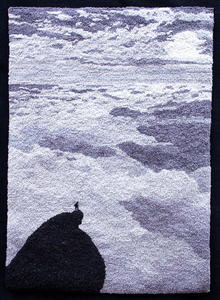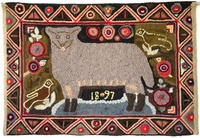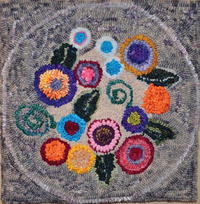Wicker & Lace
Two expert designers tell us their secrets.

Sapphire, 22" x 36", #3- to 8-cut wool on rug warp. Pattern adapted by Leonard Feenan from a photo portrait by Karen Taylor, hooked by Judy Carter, Willow Street, Pennsylvania, 2012. In the private collection of Jean Brown.
Hooking Wicker by Judy Carter
While hooking Sapphire, a portrait of a Corgi who was sitting on a wicker bench, I wondered how I was going to make the bench look as realistic as the rest of the piece. I had hooked the details, shadows, and realism throughout the piece, but what was I going to do with the bench? I planned to do reverse hooking, which is hooked on the back of the rug with long spaces in between each hooked loop. This would give me the look of the long rows of woven reeds, but how was I going to turn the corner? How would I know where to add shadows and create the upper rim of the bench?
I took the advice I give my students: look at the details on your visual aid and hook what you see. I had to experiment. My cut strips looked like the reed in the bench, so why couldn’t I re-create what I saw?
So instead of a hook, I took my gold bent needle, a strip of wool, and started experimenting. I anchored the end, then I followed the lines in the photo and on the pattern. I created the longer rows first by anchoring the strip and pulling it up through a hole at the edge of the wicker area. I then skipped many holes and took my strip down through the backing to a spot on the back where the vertical row would overlap. Next, I brought the strip up to the front of the piece a short distance from where I took the strip down through the backing. I then skipped a number of holes and went down through the backing to the back again. I continued to do this until I reached the end of the row.
I started another row. This time, I took my needle and strip down through the backing beside the middle of the long strip I had just created. I brought the needle and strip up a short distance away and then went back down through the backing in the middle of the next long strip. I alternated the rows back and forth until the entire area was covered.
Judy Carter is the author ofHooking Animals. She is a Master Artisan of the Pennsylvania Guild of Craftsmen, an accredited McGown Teacher,member of The Pearl K. McGown Guild (Conestoga Chapter), TIGHR (The International Guild of Handhooking Rugmakers), and ATHA (Woolrights and Hunterton Guilds). She was the featured exhibitor at Sauder Village Rug Hooking Week in 2015, and she teaches at workshops and rug camps. Visit her website: www.jcrugs.com.
Marilyn Becker credits her artistic mother for teaching her how beautiful the world is and how to express it in many forms of art. Primarily self-taught, Marilyn has been rug hooking only three years, and her award-winning work has been published inRHM and Celebration.
This article excerpt is from the September/October 2016 issue. For more information on our issues, check out our issues page.








